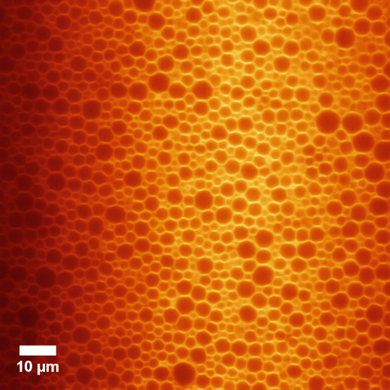 Back to projects
Back to projects

Jamming on microscale
- Supervisor: prof. dr. Daniel Bonn
- Research Team: Maureen Dinkgreve
- Goal: To investigate the jamming phenomenon in emulsions, foams and materials.
- Info: D.Bonn, M. Dinkgreve
Traffic jams are a common phenomenon on highways; with too many cars on the road the traffic gets stuck. This jamming phenomenon also occurs in everyday materials such as beauty creams and toothpaste; understanding and predicting the flow behavior of these fluids is a subject of considerable interest. Materials like emulsions, foams and suspensions can flow freely, as cars over the highway, or become “jammed”. In the latter case they behave as solids: a pile of whipped cream does not flow in spite of the fact that gravity acts on it. This happens when the concentration is high enough, forces are small. For example toothpaste, which is solid when in the tube, but flows out when you squeeze it.
It is not completely understood which parameters influence jamming in such materials, for example interaction between particles, and the nature of the jamming transition is still under heavy debate within the fluid dynamics community. Jamming is considered as a new kind of phase transition similar to a classical phase transition between solid, liquid and gas phases.
In this research, we study the flow behavior of four different fluids: two types of emulsions, a foam and a polymer gel. Based on our measurements we show that all the flow data can be split up into two regimes: one below and one above the critical jamming concentration. In order to explain the observed flow we propose a model based on microscopic heterogeneous dynamics; a theory that describes the small scale interactions that influence the discontinuous flow. Combining the experimental data with our model we are able to understand flow behavior on either side of the jamming transition. For the first time, four completely different fluids can be described with a single model. This universal model brings us closer to the understanding of this jamming phenomenon - an important result which could later find its applications in, for example, the manufacturing of body lotions and other emulsions.
